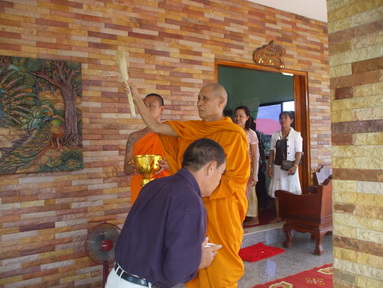|
Lustral water sprinkled by a Buddhist priest using a whisk is one of the most common forms of blessing here in Thailand. The rite comes at the conclusion of many ceremonies, but may be an independent ceremony apart from a larger event as well.
In the picture accompanying this essay the priest is flicking water over people attending a house blessing. The same priest went through the new house sprinkling each room. The instrument the priest uses is a whisk of stiff yaa-khaa; the grass is Imperata cylindrica, thatch-grass or lalang (not, as one Wiki site says, Bermuda grass which is Cynodon dactylon, another type of grass). To assess what this means, two domains of faith need to be considered. It is obvious to everyone that this act is an aspect of Buddhism here in Thailand. In the house blessing ceremony, as in many others, the naam-mon which is usually called lustral water in English was produced while priests chanted stanzas of scripture prescribed for a house blessing and “life extension” ceremony [to be discussed in another blog]. Naam-mon is also called mantra water (by Wells, K 1960, Thai Buddhism, p. 195), referring to its having been chanted into effectiveness. A white string extended from the Buddha image in the front of the room through the reverent hands of the chapter of priests assembled in a line to do the chanting. The string was then wrapped around a bowl in front of one of the priests, symbolically connecting the bowl and the priests to the Lord Buddha. As they chanted, the priest with the bowl used an upended lighted candle to drip wax into the bowl half-full of water. He moved the candle in a circular motion while the priests chanted the Namokaratthaka paritta which includes the prayer that “having expressed reverence and rightly proclaimed the Dharma there is reason to expect misfortune might be avoided, good fortune come, and strength may follow”. The fourteenth verse expresses the aspiration for enlightenment, “The wise who have destroyed the seeds [i.e. the seeds of clinging which bear fruit of reincarnation and continuation] of existence...go out like a light.” As these words are chanted the priest snuffs out the candle in the water. The second domain of faith involved in the production of naam-mon lies outside Buddhism, at least insofar as Buddhism is a religion devoid of the occult. The water to make naam-mon must come from nine different wells, I have been told. Most writings simply say that the water must come from underground. But there are certain ceremonies (e.g. one in Lampoon) wherein the water comes from 9 holy pools and in one royal celebration water was collected from the holiest source in each of the 76 provinces of Thailand. During the Songkran water festival water from washing Buddha images is collected to use exactly as naam-mon is used. When a person has been very ill a bucket-full of naam-mon is produced (with a recipe that varies greatly) including a type of pine splinters, jasmine and particular oils; the patient is soaked in this while remaining outside the boundaries of a residential property or temple grounds. From this diversity, as is always the case with the supernatural domain of faith, it is clear there is no uniform procedure. Within Buddhism there are two schools of thought about these kinds of practices. The stricter school frowns on such things and tries to restrict their use, calling them superstitions which divert attention from the message of Dharma. The more popular school remembers that the Lord Buddha had little to say about routine human affairs such as house blessings, weddings and the like. The assumption is that prevailing practices on those occasions were not set aside. Those aspects of religion and life were left in the charge of Brahmin priests (and remain so to this day in many royal ceremonies). Some of what the Brahmin priests did was taken over by Buddhist priests. They are considered additions to their monastic duties. On closer examination it is clear, however, that in this and countless other instances, faith domains not only co-exist, but overlap, intermix and are inseparable. This is not pandering to popular preference for the mysterious, as purists sniff. It is an expression of need for intervention in troubled human affairs. The need may be penultimate from a Buddhist point of view. The ultimate need may be for detachment, awareness of the truth about reality, and deliverance from enslavement to ego. But in the meantime, for those less endowed with intellectual gifts and persistence, the vicissitudes of this world require contributions of hope, symbolized, simplified and widely respected. That is what rituals provide. In Christianity and some other faith systems water is a symbol of cleansing, the washing away of those things which are barriers to devout and eternal life. It seems that in Thai Buddhism the water symbolizes not so much what is removed, but that which is added. Naam-mon enhances one's condition, adds power, and sustains life. Of course it is not the few drops of water that do this, but the power invested by the chanting and in the other esoteric processes hinted at and alluded to, delivered in the drops of water. The effect is already disbursed, but the water makes the effect immediate.
0 Comments
Leave a Reply. |
AuthorRev. Dr. Kenneth Dobson posts his weekly reflections on this blog. Archives
March 2024
Categories |
| Ken Dobson's Queer Ruminations from Thailand |
|

 RSS Feed
RSS Feed
